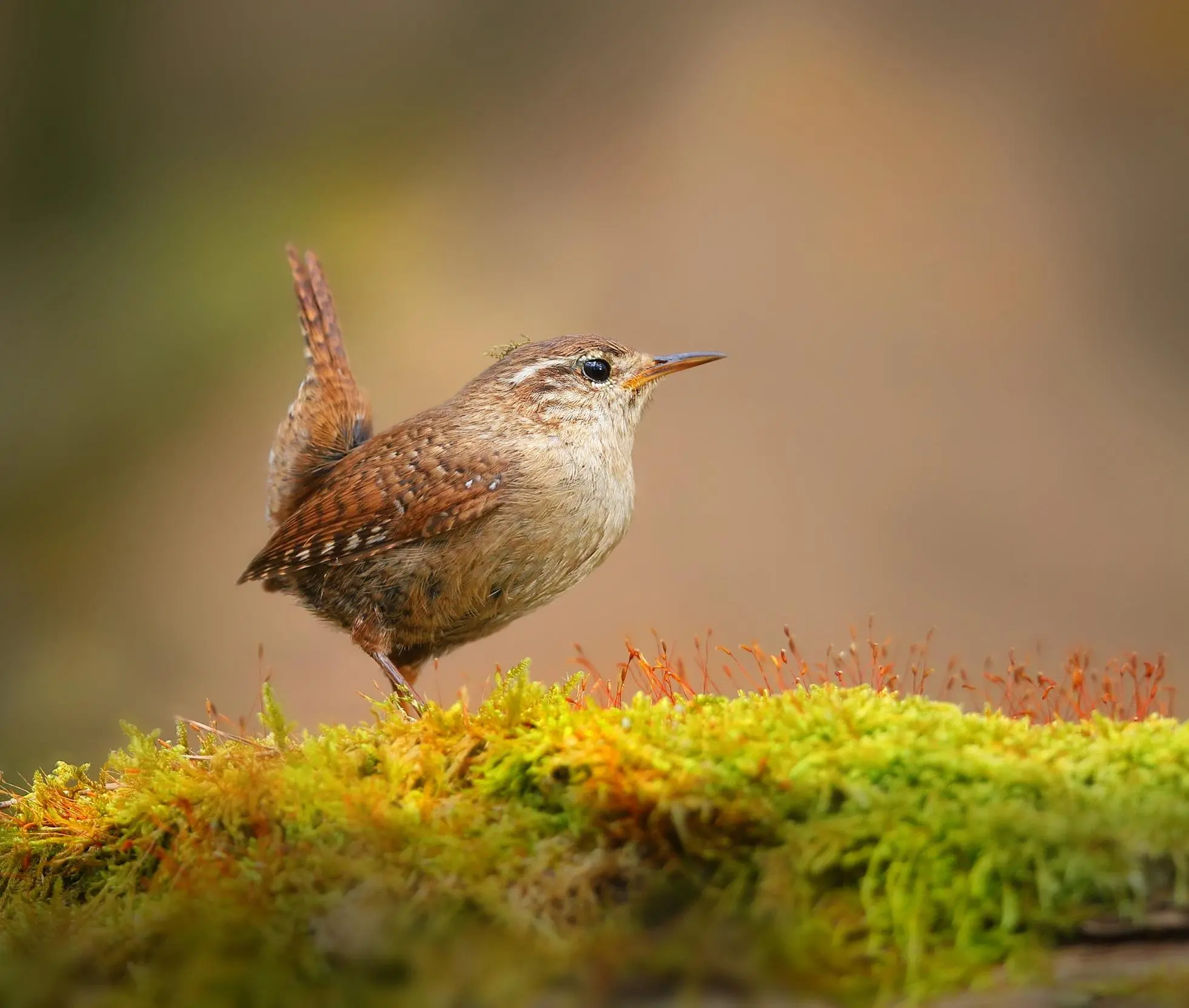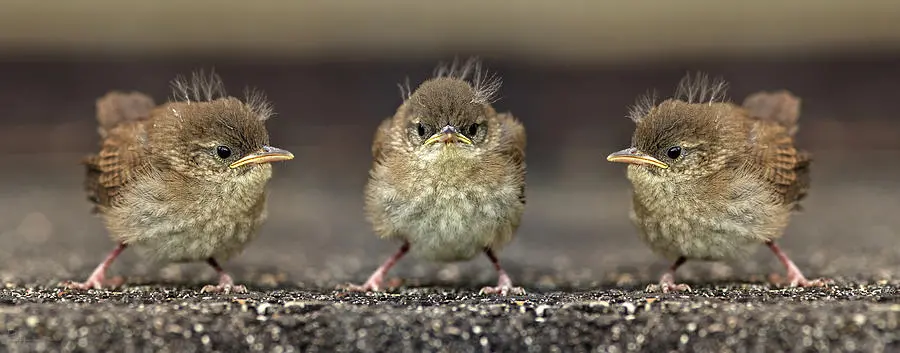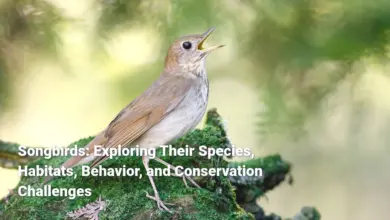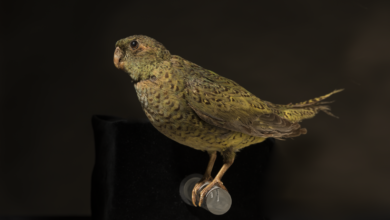Wren Bird: Detailed Insights into Characteristics, Habitat, Behavior, Reproduction, and Cultural Significance
An In-Depth Exploration of Wren Birds: Characteristics, Habitat, Behavior, Reproduction, and Their Cultural Impact
Wren Birds, with their small size and spirited behavior, encapsulate the essence of avian charm. Belonging to the family Troglodytidae, these delightful birds are primarily distributed across the Americas and Europe. Their vibrant songs, distinctive physical characteristics, and fascinating lifestyles have made them a subject of fascination for many birdwatchers and ornithologists. While they may not capture the attention of larger birds, wrens offer a wealth of information and intrigue for those willing to look closely.

These birds are often described as energetic and full of life, and their behaviors reveal a complex interplay between adaptability and social interaction. From their nesting strategies to their foraging habits, Wren Birds have developed a suite of traits that allows them to thrive in diverse environments. Understanding the intricacies of wrens provides an opportunity to appreciate not just their beauty, but also their ecological significance. In this article, we will explore the many facets of wrens, including their characteristics, behavior, habitats, reproduction, diet, notable species, and cultural significance.
Characteristics of Wren Bird
Wren Birds are notable for their vibrant personality despite their diminutive size. While they are often drab in coloration typically a palette of browns and grays their robust bodies and lively movements imbue them with a sense of vitality that captures the eye. Picture a small, yet lively conductor, orchestrating the symphonies of their environment with each flutter and chirp.
In comparison to other songbirds, Wren Birds stand out due to their compact figure. They range in size from the tiny white-bellied wren, measuring only about 3.9 inches, to the giant wren, which can grow up to 8.7 inches. Though they may be small, they boast an impressive wingspan, allowing for quick movement through thick underbrush.
Physical Appearance
Wren Birds have several distinguishing features that make them easily identifiable. Their bodies are small and round, with relatively long tails that they often hold upright, adding to their animated posture. The coloration of most species tends to feature a blend of browns, offering them a camouflage that is ideal for their natural habitats.
- Coloration: Wrens typically exhibit a mix of rusty brown or gray upperparts, often adorned with speckled or barred patterns. Their underbellies tend to be lighter, creating a stark contrast that enhances their unique appearance.
- Eyebrow Marking: A notable feature is the distinctive white eyebrow marking above their eyes, which aids in species identification and adds a dash of character to their appearance.
- Bill: Wrens possess a long, slender bill that is slightly curved downwards and specially adapted for probing into foliage and crevices to search for insects.
Overall, their combination of charming physical attributes and engaging behaviors makes wrens an appealing subject for birdwatching enthusiasts.
Size and Weight
When discussing the size and weight of Wren Birds, one can appreciate how their petite form is perfectly suited for their lifestyle. Most species range between 3.9 to 8.7 inches in length and weigh from 0.32 to 1.8 ounces. This lightweight stature allows them to swiftly navigate through dense vegetation in search of food and shelter.
| Species | Length (inches) | Weight (ounces) |
|---|---|---|
| White-bellied Wren | 3.9 | 0.32 |
| House Wren | 4.3 – 5.1 | 0.3 – 0.4 |
| Winter Wren | 4.0 – 4.6 | 0.3 |
| Eurasian Wren | 3.5 – 4.7 | 0.4 |
| Giant Wren | 8.7 | 1.8 |
These measurements illustrate the captivating diversity found within the wren family. Their small size is counterbalanced by an impressive energy level and determination that speaks to their adaptability.
Distinctive Features
Wren Birds’ physical attributes extend beyond size and plumage; they also possess several distinctive features that cater to their lifestyle.
- Tail: Wrens are characterized by their short and pointed tails that they often hold in an elevated position. This tail function assists in maintaining balance as they dart through dense undergrowth.
- Vocalization: While not a physical characteristic, it’s hard to overlook the significance of wren vocalizations. Known for their complex and loud songs, these tiny birds produce a variety of trills and chirps that can be remarkably robust, given their size. This vocal prowess serves not only to attract mates but also assert territory.
- Adaptation: The unique features of wrens, including their compact bodies, agile movements, and vibrant songs, serve as adaptations that allow them to thrive in various environments, reflecting their evolutionary history and ecological versatility.
In the realms of nature watching, these distinctive features make wrens a rewarding sight, representing the marvels of adaptation and survival in an often challenging world.
Habitat and Distribution
Wren Birdsthrive in a multitude of environments, showcasing their adaptability and resilience across various climates and landscapes. Their habitats range from dense forests and wetlands to suburban gardens and deserts.
While the House Wren excels in urban landscapes, adapting to human presence and flourishing in backyards, the Eurasian Wren demonstrates its ability to survive in more challenging terrains, including coastal regions and high-altitude forests.
A comparison between some well-known Wren Birds illustrates their diverse habitat preferences:
| Species | Primary Habitat | Geographic Range |
|---|---|---|
| House Wren | Open areas with shrubs, parks, gardens | Widespread across North and South America |
| Eurasian Wren | Dense undergrowth in woodlands | Europe, Asia, West of Africa |
| Winter Wren | Moist forests near wetlands | North America, primarily in the eastern regions |
Together, these habitat preferences indicate the wide-ranging nature of Wren Birds and their capacity to adapt to environments altered by human activity.
Preferred Habitats
Each species of wren tends to favor particular habitats that provide essential resources such as food, nesting sites, and protection from predators.
- House Wren: Favored habitats include gardens, parks, and open woodlands. They often thrive in urban areas where they find ample nesting cavities in human-made structures. Their adaptability allows them to utilize a wide variety of locations, including birdhouses.
- Eurasian Wren: This species prefers dense undergrowth, typically found in woodlands and hedges. Its ability to penetrate different types of environments including gardens and higher altitudes demonstrates remarkable adaptability.
- Winter Wren: Found mainly in moist, dense forests, particularly near water sources like streams and marshes. They prefer habitats where the understory is thick, providing security and ample insect life for foraging.
- Carolina Wren: This species favors open woods and brushy areas. They are particularly fond of habitats that offer dense cover, which aids in foraging and nesting.
Through their habitat preferences, Wren Birds reflect the delicate balance within ecosystems; they contribute to pest control and thus play essential roles in maintaining healthy environments.
Geographic Range
Wren Birds exhibit various geographic ranges that align with the diversity of their respective habitats. Most are found in North America, but notable exceptions like the Eurasian Wren extend their range into Europe and parts of Asia and North Africa.
| Species | Range |
|---|---|
| House Wren | Canada to southernmost South America |
| Eurasian Wren | Europe, Asia, North Africa |
| Winter Wren | North America (breeding primarily in the North) |
| Carolina Wren | Southeastern United States |
Their substantial ranges showcase not only the diversity within the family but also their adaptability in facing changing environmental conditions. This adaptability is a clear indicator of their evolutionary success.
Adaptability to Environments
One of the most notable qualities of Wren Birds is their adaptability, which allows them to thrive in an array of environmental conditions. This remarkable trait can be observed in various aspects of their behavior.
- Nesting Flexibility: Wrens often utilize a variety of nesting sites, demonstrating a keen ability to work with what is available. The House Wren, for example, can nesting in everything from tree holes to abandoned containers, highlighting their resourcefulness.
- Dietary Adaptations: Wrens adjust their diets seasonally to capitalize on available food resources. For instance, in spring, they focus on caterpillars to feed their young, while in winter, they may substitute insects with plant matter, such as berries.
- Urban Resilience: Many species, particularly the House Wren, have adapted well to human-altered environments, finding homes in cities and suburban areas. This behavior allows them to thrive where other birds may struggle.
- Seasonal Behavior: Some wrens exhibit migratory patterns, while others remain residents year-round. Their flexibility regarding migration and territorial behavior enables them to cope with seasonal variations in food availability.
In essence, the behavioral adaptability of wrens reveals their capability to survive and thrive in changing environmental conditions, making them remarkable survivors.
Behavior and Lifestyle
Wren Birds, small in stature yet large in personality, demonstrate a myriad of behaviors that contribute to their vibrant lifestyles. Whether it’s their foraging techniques, vocal behaviors, or nesting strategies, they illustrate a carefully nuanced relationship with their surroundings.

Most Wren Birds are diurnal, meaning they are primarily active during the day, often solitary or living in family groups. Their lively nature becomes evident in the vibrant songs that fill their habitats, particularly during mating season. Unlike some birds that prefer social flocks, wrens often favor a solitary existence or pair bonding, making their interactions all the more special.
Foraging and Feeding Habits
Wren Birds are primarily insectivorous, and their feeding habits reveal a high level of interactivity with their environment. They are active and agile foragers, often seen hopping around on the ground, rummaging through foliage to find various insects.
- Diverse Diet: Insects constitute a major portion of their diet, including beetles, spiders, and larvae. They utilize their slender bills to probe crevices and foliage for hidden food, showcasing their adaptability.
- Foraging Techniques: Wrens typically employ a mix of methods for foraging:
- Ground Foraging: Many species predominantly forage on the ground, turning over leaves to uncover insects beneath.
- Vertical Movements: Some wrens climb low branches to access insects hidden in bark.
- Seasonal Shifts in Diet: As seasons change, so does their diet:
- In spring, caterpillars are a primary food source for adult birds feeding nestlings.
- In winter, when insect availability decreases, wrens may turn to fruits and seeds.
Through diligent foraging, wrens play a crucial role in maintaining the health of their ecosystems by controlling pest populations.
Nesting Strategies
The nesting behavior of Wren Birds varies by species but often displays remarkable ingenuity and resourcefulness. Wren Birds typically exhibit a mix of behaviors when building nests, with males playing a central role in the process.
- Nesting Sites: Wrens are cavity-nesting birds and can find homes in natural and artificial spaces, including:
- Old cans, boots, and boxes
- Nesting boxes placed in gardens
- Natural cavities in trees and shrubs
- Nest Construction: Males often lead the construction, laying a foundation with sticks and twigs. Females subsequently line the nest with softer materials such as feathers, moss, and grass to create a comfortable environment for incubation.
- Nest Reuse: In some cases, wrens may reuse nests from previous seasons, making repairs and modifications as necessary. This behavior speaks to their adaptability and resourcefulness.
With these nesting strategies, wrens are well-equipped to raise their young successfully, showcasing an impressive blend of social and individual behaviors.
Vocalizations and Communication
The vocalizations of Wren Birds are a defining characteristic and play a significant role in their behaviors. Their songs can vary immensely among species but tend to be rich and melodious.
- Territorial Calls: Males establish their territories through song, creating a complex soundscape filled with trills and whistles. The loud and energetic songs serve to ward off rivals and attract potential mates.
- Communication: Wrens use vocalizations for various purposes, including:
- Attracting Mates: Males serenade females with intricate songs.
- Family Communication: Parents may use soft calls to communicate with their chicks.
- Individual Variability: Each male possesses unique vocal patterns, allowing them to establish individual identities. This variability fosters a sense of community while also promoting individual recognition among mates.
This reliance on vocalizations not only aids in mating and territory establishment but also highlights the social complexity of wrens, underscoring their dynamic lifestyle.
Reproduction and Life Cycle
Wren Birds display a variety of mating habits and reproductive strategies, underscoring the complexity of their life cycles. Two species, the Carolina Wren and House Wren, demonstrate fascinating insights into wren reproduction.
Mating Habits
- Monogamous Relationships: Carolina Wrens tend to form long-term pair bonds. They engage in social behaviors such as singing duets, a charming display of cooperation between the sexes.
- Competitive Nesting: On the other hand, House Wrens exhibit more competitive mating practices. Males often build multiple nests to attract females, showcasing their resourcefulness and vitality.
- Aggressive Behavior: House Wrens are known to be aggressive, sometimes evicting other birds from their nesting sites to secure favorable locations, demonstrating their competitive nature.
Nesting and Incubation
The nesting process for these birds is critical for ensuring the survival of their young. Wren nests are typically constructed within sheltered spaces, emphasizing the need for protection.
- Nest Construction:
- Males play a significant role in building and assembling nests from various materials, including grass, foliage, and other soft items.
- The female inspects and lines the nest, ensuring it is well-constructed and secure.
- Egg Laying:
- Female wrens typically lay between 3 and 10 eggs, which can vary based on environmental conditions and food supply.
- The eggs are usually cream or white, sometimes speckled, emphasizing their need for camouflage within the nest environment.
- Incubation and Fledging: The incubation period lasts between 10 to 16 days, depending on the species. Once hatched, wrens are altricial and require significant parental care. Fledging usually occurs after about 12 to 17 days, with parents continuing to aid in their development.
Through their mating habits and reproductive strategies, Wren Birds highlight the balance between competition and cooperation, ensuring successful propagation within their species.
Development of Chicks
Once the chicks hatch, they are entirely dependent on their parents for survival. The development phase is crucial, laying the groundwork for future independence.
- Parental Care:
- Both parents are involved in feeding and protecting their young, showcasing cooperative parenting.
- Young wrens are fed a high-protein diet consisting predominantly of insects, essential for their growth.
- Learning to Forage:
- Following fledging, young wrens rely on their parents to learn essential foraging skills. This stage is critical as they begin to explore their environment and establish their own territories.
- Seasonal Brood Production:
- Female wrens may lay multiple clutches within a breeding season, while males demonstrate willingness to care for fledglings, aiding in their survival during this formative stage.
Through attentive parental care and social behaviors, young wrens transition from vulnerable chicks to independent adults, ensuring the continuity of their lineage.
Diet and Nutrition
Wren Birds primarily follow an insectivorous diet, showcasing a remarkable ability to adapt their feeding habits according to seasonal changes and resource availability.
Insectivorous Diet
- Primary Food Sources:
- Wrens consume an array of invertebrates, including insects like beetles, caterpillars, spiders, and larvae, showcasing their adaptability.
- Their foraging skills allow them to exploit various feeding strategies, capitalizing on the most available food at any given time.
- Feeding Frequency:
- On average, an adult wren can consume about 20 to 30 percent of its body weight each day, demonstrating the nutritional demands of small birds.
- Opportunistic Feeders: Wrens exhibit opportunistic feeding behavior, adjusting their diet based on seasonal availability:
- In spring, they prioritize caterpillars to feed their young.
- In winter, they may eat fruits and nuts when insects become scarce.
Seasonal Dietary Changes
As seasons change, so do the dietary habits of wrens, showcasing their ability to adapt to varying environmental conditions.
- Spring and Summer:
- During the breeding season, wrens rely heavily on insects for energy and nourishment. Diet variations during these periods are influenced by the increased availability of specific insects.
- Caterpillars are particularly sought after as they provide high protein, essential for raising young.
- Fall and Winter:
- In the colder months, when insects are less readily available, wrens may increase their consumption of berries and seeds, helping them build fat reserves for the winter.
- They are known to forage around gardens and bird feeders, where food is provided by humans.
Foraging Techniques
The foraging behaviors of Wren Birds are finely tuned to their environments, allowing them to maximize their food intake effectively.
- Active Ground Foraging:
- Wrens are often seen hopping along the forest floor, actively searching for insects hidden in leaves or crevices.
- Probing:
- Their specialized bills enable them to probe into bark and foliage, uncovering hidden food sources while getting deeper into crevices compared to other birds.
- Agility:
- Wrens exhibit remarkable agility, darting through underbrush and exhibiting quick reflexes to catch prey.
Through their energetic foraging techniques and dietary versatility, wrens play a crucial role in regulating insect populations, contributing to the ecosystem’s health.
Notable Wren Species
Various species of wrens possess their unique characteristics, behaviors, and habitats, demonstrating the diversity of this engaging bird family. Here, we examine three notable species: the Eurasian Wren, the House Wren, and the Winter Wren.
Eurasian Wren
The Eurasian Wren, known scientifically as Troglodytes troglodytes, stands out for its adaptability and wide distribution.
- Physical Characteristics: This small bird has a plump body with short, pointed wings and a distinctive appearance of rufous-brown plumage characterized by faint barring on the underparts.
- Vocalization: Its song is robust, featuring a series of melodious trills and whistles that are surprisingly loud for its size, often heard throughout the day.
- Habitat: It thrives in various environments woodlands, gardens, and even coastal areas. Its ability to inhabit diverse habitats speaks to its adaptation skills.
- Reproductive Behavior: Males engage in polygamous behavior, building multiple nests within their range to entice females. This strategy demonstrates the wren’s competitive mating habits.
House Wren
The House Wren (Troglodytes aedon) is widely recognized for its cheerful demeanor and adaptability to human-altered environments.
- Physical Characteristics: Characterized by its brown plumage with darker barring, the House Wren is slightly larger than its Eurasian counterpart. It measures about 4.3 to 5.1 inches in length.
- Habitat: This species boasts a significant range from Canada to southern South America, commonly found in backyards, parks, and urban gardens.
- Vocalization: The bubbly and energetic songs during the breeding season create a lively atmosphere, underscoring the species’ exuberant lifestyle.
- Nesting Behavior: House Wrens display fascinating nesting strategies, often creating multiple nests to attract potential mates, showcasing their resourcefulness in finding nesting sites.
Winter Wren
The Winter Wren (Troglodytes hiemalis) is another engaging member of this family, preferred for its elusive nature and melodious songs.
- Physical Characteristics: Slightly smaller than the House Wren, the Winter Wren features streaked brown upper parts with lighter underparts a classic indicator distinguishing it from other wrens.
- Habitat: They favor dense, moist forests and are often found near water sources. Their secretive nature makes them harder to spot in their natural habitats.
- Vocalization: With their melodious songs resonating year-round, Winter Wrens contribute significantly to the soundscape of their habitats.
- Nesting Behavior: Similar to other wrens, they build nests in hidden locations, often within tucked-away cavities in trees or thick underbrush.
These notable wren species showcase the delightful diversity within the family, each contributing uniquely to their ecosystems and enchanting those who take the time to observe them.
Cultural Significance
Wren Birds have woven themselves into the fabric of human culture across centuries, manifesting in folklore, mythology, and artistic representations. Their symbolic significance reflects human perceptions of nature, harmony, and resilience.
Folklore and Myths
Wren Birds have appeared in various cultural tales, symbolizing cleverness, resourcefulness, and ingenuity.
- Celtic Legend: In Celtic mythology, the wren is often referred to as the “king of all birds.” A popular story features the wren hiding on the back of an eagle to win a flight race, emphasizing intelligence over brute strength and resilience despite its small size.
- Symbol of Spring: Across cultures, the wren is seen as a harbinger of spring. In Welsh tradition, spotting the first wren is regarded as an omen of good fortune, celebrating the bird’s arrival as a sign of renewal.
- Superstitions: Various folklore tales in different cultures depict wrens’ behavior as omens. For example, a wren entering a home may signal a change, while tapping at windows can be seen as a sign of impending funerals.
Representation in Art and Literature
Wren Birds have inspired countless artistic and literary works, emphasizing their symbolic associations and charisma.
- Poetic Symbol: In literature, wrens symbolize cleverness and adaptability. Their melodies and behavior often serve as metaphors for love, creativity, and life’s transience.
- Artistic Representations: Wrens appear in various artistic motifs, particularly in Celtic art, celebrating their beauty and charm and associating them with themes of spring and renewal.
- Cultural Practices: The “Wren Day” tradition, celebrated in places like Ireland, showcases the bird’s cultural relevance. Young men, often referred to as “wren boys,” formerly hunted wrens as part of a festive celebration, reinforcing themes of community and cooperation.
Impact on Human Culture
Wren Birds resonate with humanity at multiple levels, often acting as enduring symbols of resilience, creativity, and connection to nature.
- Cultural Sessions: Various cultural practices and customs surrounding wrens reinforce the significance of these birds in human narratives bridging themes of nature and divinity while serving as poignant reminders of our connection to the natural world.
- National Symbolism: In some cultures, the wren is viewed as a national symbol, reflecting history, community, and cultural identity, often invoked during grassroots movements and celebrations of national pride.
- Inspiring Creativity: The wren’s vibrant songs and lively behavior have inspired poets, musicians, and artists to incorporate elements of their essence into their creative works, illustrating the unyielding imprints of life that carry over from nature to human expression.
In essence, Wren Birds weave a narrative through culture that celebrates nature’s intricacies, showcasing their link to human experience, nature, and symbolic significance across varying contexts.
Conclusion
In summary, Wren Birds are small yet fascinating birds that exhibit a remarkable array of behaviors, adaptations, and cultural significance. From their distinctive physical characteristics to their vibrant songs, they capture the imagination of birdwatchers and nature enthusiasts alike. Not only do they play critical roles within their ecosystems, particularly through their feeding habits and nesting strategies, but they are also steeped in rich cultural narratives that highlight their importance in folklore and art.
As we explore the layers of wren life, we discover their inherent charm and ecological value, offering deeper appreciation for these humble yet captivating birds of our environment. By recognizing their significance and ensuring the preservation of their habitats, we can continue to enjoy the presence of Wren Birds in our backyards and beyond.









